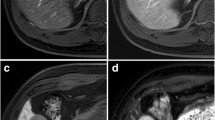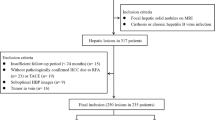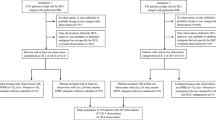Abstract
Objectives
We aimed to develop and evaluate a modified Liver Imaging Reporting and Data System (LI-RADS) version 2018 using significant ancillary features for diagnosing hepatocellular carcinoma (HCC) < 1.0 cm on gadoxetate disodium–enhanced magnetic resonance imaging (MRI).
Methods
Patients who underwent preoperative gadoxetate disodium–enhanced MRI for focal solid nodules < 2.0 cm within 1 month of MRI between January 2016 and December 2020 were retrospectively analyzed. Major and ancillary features were compared between HCCs of < 1.0 cm and 1.0–1.9 cm using the chi-square test. Significant ancillary features associated with HCC < 1.0 cm were determined by univariable and multivariable logistic regression analysis. The sensitivity and specificity of LR-5 were compared between LI-RADS v2018 and our modified LI-RADS (applying the significant ancillary feature) using generalized estimating equations.
Results
Of 796 included nodules, 248 were < 1.0 cm and 548 were 1.0–1.9 cm. HCC < 1.0 cm less frequently showed an enhancing capsule (7.1% vs. 31.1%, p < .001) and threshold growth (0% vs. 8.3%, p = .007) than HCC of 1.0−1.9 cm. Restricted diffusion was the only ancillary feature significant for diagnosing HCC < 1.0 cm (adjusted odds ratio = 11.50, p < .001). In the diagnosis of HCC, our modified LI-RADS using restricted diffusion had significantly higher sensitivity than LI-RADS v2018 (61.8% vs. 53.5%, p < .001), with similar specificity (97.3% vs. 97.8%, p = .157).
Conclusion
Restricted diffusion was the only significant independent ancillary feature for diagnosing HCC < 1.0 cm. Our modified LI-RADS using restricted diffusion can improve the sensitivity for HCC < 1.0 cm.
Key Points
• The imaging features of hepatocellular carcinoma (HCC) < 1.0 cm differed from those of HCC of 1.0–1.9 cm.
• Restricted diffusion was the only significant independent ancillary feature for HCC < 1.0 cm.
• Modified Liver Imaging Reporting and Data System (LI-RADS) with the addition of restricted diffusion can improve the sensitivity for HCC < 1.0 cm.



Similar content being viewed by others
Abbreviations
- APHE:
-
Arterial-phase hyperenhancement
- CCA:
-
Cholangiocarcinoma
- CT:
-
Computed tomography
- DWI:
-
Diffusion-weighted image
- HBP:
-
Hepatobiliary-phase image
- HCC:
-
Hepatocellular carcinoma
- LI-RADS:
-
Liver Imaging Reporting and Data System
- MRI:
-
Magnetic resonance imaging
- TP:
-
Transitional phase
References
McGlynn KA, Petrick JL, El-Serag HB (2021) Epidemiology of hepatocellular carcinoma. Hepatology 73(Suppl 1):4–13
Llovet JM, Fuster J, Bruix J (2004) The Barcelona approach: diagnosis, staging, and treatment of hepatocellular carcinoma. Liver Transpl 10:S115-120
Hasegawa K, Kokudo N, Makuuchi M et al (2013) Comparison of resection and ablation for hepatocellular carcinoma: a cohort study based on a Japanese nationwide survey. J Hepatol 58:724–729
Marrero JA, Kulik LM, Sirlin CB et al (2018) Diagnosis, staging, and management of hepatocellular carcinoma: 2018 Practice Guidance by the American Association for the Study of Liver Diseases. Hepatology 68:723–750
European Association for the Study of the Liver (2018) EASL Clinical practice guidelines: management of hepatocellular carcinoma. J Hepatol 69:182–236
Fan PL, Chu J, Wang Q, Wang C (2022) The clinical value of dual-energy computed tomography and diffusion-weighted imaging in the context of liver cancer: a narrative review. J Clin Ultrasound 50:862–868
Joo I, Lee JM (2016) Recent advances in the imaging diagnosis of hepatocellular carcinoma: value of gadoxetic acid-enhanced MRI. Liver Cancer 5:67–87
Ichikawa T, Saito K, Yoshioka N et al (2010) Detection and characterization of focal liver lesions: a Japanese phase III, multicenter comparison between gadoxetic acid disodium-enhanced magnetic resonance imaging and contrast-enhanced computed tomography predominantly in patients with hepatocellular carcinoma and chronic liver disease. Invest Radiol 45:133–141
Choi SH, Byun JH, Lim YS et al (2016) Diagnostic criteria for hepatocellular carcinoma ⩽3 cm with hepatocyte-specific contrast-enhanced magnetic resonance imaging. J Hepatol 64:1099–1107
Omata M, Cheng AL, Kokudo N et al (2017) Asia-Pacific clinical practice guidelines on the management of hepatocellular carcinoma: a 2017 update. Hepatol Int 11:317–370
Kudo M, Matsui O, Izumi N, Iijima H, Kadoya M, Imai Y (2014) Surveillance and diagnostic algorithm for hepatocellular carcinoma proposed by the Liver Cancer Study Group of Japan: 2014 update. Oncology 87(Suppl 1):7–21
Lee S, Kim SS, Chang DR, Kim H, Kim MJ (2020) Comparison of LI-RADS 2018 and KLCA-NCC 2018 for noninvasive diagnosis of hepatocellular carcinoma using magnetic resonance imaging. Clin Mol Hepatol 26:340–351
Kim DH, Choi SH, Byun JH et al (2019) Arterial subtraction images of gadoxetate-enhanced MRI improve diagnosis of early-stage hepatocellular carcinoma. J Hepatol 71:534–542
Park CJ, An C, Park S, Choi JY, Kim MJ (2018) Management of subcentimetre arterially enhancing and hepatobiliary hypointense lesions on gadoxetic acid-enhanced MRI in patients at risk for HCC. Eur Radiol 28:1476–1484
GuPta PP, Lohiya N (2022) Radiological outcome of subcentimeter arterially enhancing nodules detected during surveillance for hepatocellular carcinoma-a cohort study. J Clin Diagn Res 16:TC01-TC05
Song KD, Lee MW, Rhim H et al (2018) Percutaneous US/MRI fusion-guided radiofrequency ablation for recurrent subcentimeter hepatocellular carcinoma: technical feasibility and therapeutic outcomes. Radiology 288:878–886
Kim BJ, Choi SH, Kim SY et al (2022) Liver Imaging Reporting and Data System categories: long-term imaging outcomes in a prospective surveillance cohort. Liver Int 42:1648–1657
Yu MH, Kim JH, Yoon JH et al (2014) Small (≤1-cm) hepatocellular carcinoma: diagnostic performance and imaging features at gadoxetic acid-enhanced MR imaging. Radiology 271:748–760
Campos-Correia D, Cruz J, Matos AP, Figueiredo F, Ramalho M (2018) Magnetic resonance imaging ancillary features used in Liver Imaging Reporting and Data System: an illustrative review. World J Radiol 10:9–23
Park JH, Chung YE, Seo N, Choi JY, Park MS, Kim MJ (2021) Should threshold growth be considered a major feature in the diagnosis of hepatocellular carcinoma using LI-RADS? Korean J Radiol 22:1628–1639
Cerny M, Chernyak V, Olivié D et al (2018) LI-RADS version 2018 ancillary features at MRI. Radiographics 38:1973–2001
Chernyak V, Fowler KJ, Heiken JP, Sirlin CB (2019) Use of gadoxetate disodium in patients with chronic liver disease and its implications for liver imaging reporting and data system (LI-RADS). J Magn Reson Imaging 49:1236–1252
Kang JH, Choi SH, Byun JH et al (2020) Ancillary features in the Liver Imaging Reporting and Data System: how to improve diagnosis of hepatocellular carcinoma ≤ 3 cm on magnetic resonance imaging. Eur Radiol 30:2881–2889
Sano K, Ichikawa T, Motosugi U et al (2011) Imaging study of early hepatocellular carcinoma: usefulness of gadoxetic acid-enhanced MR imaging. Radiology 261:834–844
Zhang Y, Liu M, Zhang Q et al (2020) MRI in the differential diagnosis between well-differentiated hepatocellular carcinomas and high-grade dysplastic nodules in cirrhotic liver. Radiol Infect Dis 7:22–27
Renzulli M, Biselli M, Brocchi S et al (2018) New hallmark of hepatocellular carcinoma, early hepatocellular carcinoma and high-grade dysplastic nodules on Gd-EOB-DTPA MRI in patients with cirrhosis: a new diagnostic algorithm. Gut 67:1674–1682
Park MJ, Kim YK, Lee MW et al (2012) Small hepatocellular carcinomas: improved sensitivity by combining gadoxetic acid-enhanced and diffusion-weighted MR imaging patterns. Radiology 264:761–770
Hwang J, Kim YK, Kim JM, Lee WJ, Choi D, Hong SS (2014) Pretransplant diagnosis of hepatocellular carcinoma by gadoxetic acid-enhanced and diffusion-weighted magnetic resonance imaging. Liver Transpl 20:1436–1446
**e S, Zhang Y, Chen J et al (2022) Can modified LI-RADS increase the sensitivity of LI-RADS v2018 for the diagnosis of 10–19 mm hepatocellular carcinoma on gadoxetic acid-enhanced MRI? Abdom Radiol (NY) 47:596–607
Kim DH, Choi SH, Kim SY, Kim MJ, Lee SS, Byun JH (2019) Gadoxetic acid-enhanced MRI of hepatocellular carcinoma: value of washout in transitional and hepatobiliary phases. Radiology 291:651–657
Jang JK, Choi SH, Byun JH et al (2022) New strategy for Liver Imaging Reporting and Data System category M to improve diagnostic performance of MRI for hepatocellular carcinoma ≤ 3.0 cm. Abdom Radiol (NY) 47:2289–2298
Rong D, He B, Tang W et al (2022) Comparison of gadobenate-enhanced MRI and gadoxetate-enhanced MRI for hepatocellular carcinoma detection using LI-RADS version 2018: a prospective intraindividual randomized study. AJR Am J Roentgenol 218:687–698
Song JS, Choi EJ, Hwang SB, Hwang HP, Choi H (2019) LI-RADS v2014 categorization of hepatocellular carcinoma: intraindividual comparison between gadopentetate dimeglumine-enhanced MRI and gadoxetic acid-enhanced MRI. Eur Radiol 29:401–410
Allen BC, Ho LM, Jaffe TA, Miller CM, Mazurowski MA, Bashir MR (2018) Comparison of visualization rates of LI-RADS version 2014 major features with IV gadobenate dimeglumine or gadoxetate disodium in patients at risk for hepatocellular carcinoma. AJR Am J Roentgenol 210:1266–1272
Paisant A, Vilgrain V, Riou J et al (2020) Comparison of extracellular and hepatobiliary MR contrast agents for the diagnosis of small HCCs. J Hepatol 72:937–945
Kim DW, Choi SH, Kim SY et al (2020) Diagnostic performance of MRI for HCC according to contrast agent type: a systematic review and meta-analysis. Hepatol Int 14(6):1009–1022
Funding
The authors state that this work has not received any funding.
Author information
Authors and Affiliations
Corresponding author
Ethics declarations
Guarantor
The scientific guarantor of this publication is Sang Hyun Choi.
Conflict of Interest
The authors of this manuscript declare no relationships with any companies, whose products or services may be related to the subject matter of the article.
Statistics and Biometry
No complex statistical methods were necessary for this paper.
Informed Consent
Written informed consent was waived by the Institutional Review Board.
Ethical Approval
Institutional Review Board approval was obtained by Asan Medical Center.
Methodology
• Retrospective
• Diagnostic study
• Performed at one institution
Additional information
Publisher's note
Springer Nature remains neutral with regard to jurisdictional claims in published maps and institutional affiliations.
Supplementary Information
Below is the link to the electronic supplementary material.
Rights and permissions
Springer Nature or its licensor (e.g. a society or other partner) holds exclusive rights to this article under a publishing agreement with the author(s) or other rightsholder(s); author self-archiving of the accepted manuscript version of this article is solely governed by the terms of such publishing agreement and applicable law.
About this article
Cite this article
Jang, H.J., Choi, S.H., Choi, S.J. et al. LI-RADS version 2018 for hepatocellular carcinoma < 1.0 cm on gadoxetate disodium–enhanced magnetic resonance imaging. Eur Radiol 33, 5792–5800 (2023). https://doi.org/10.1007/s00330-023-09554-8
Received:
Revised:
Accepted:
Published:
Issue Date:
DOI: https://doi.org/10.1007/s00330-023-09554-8




